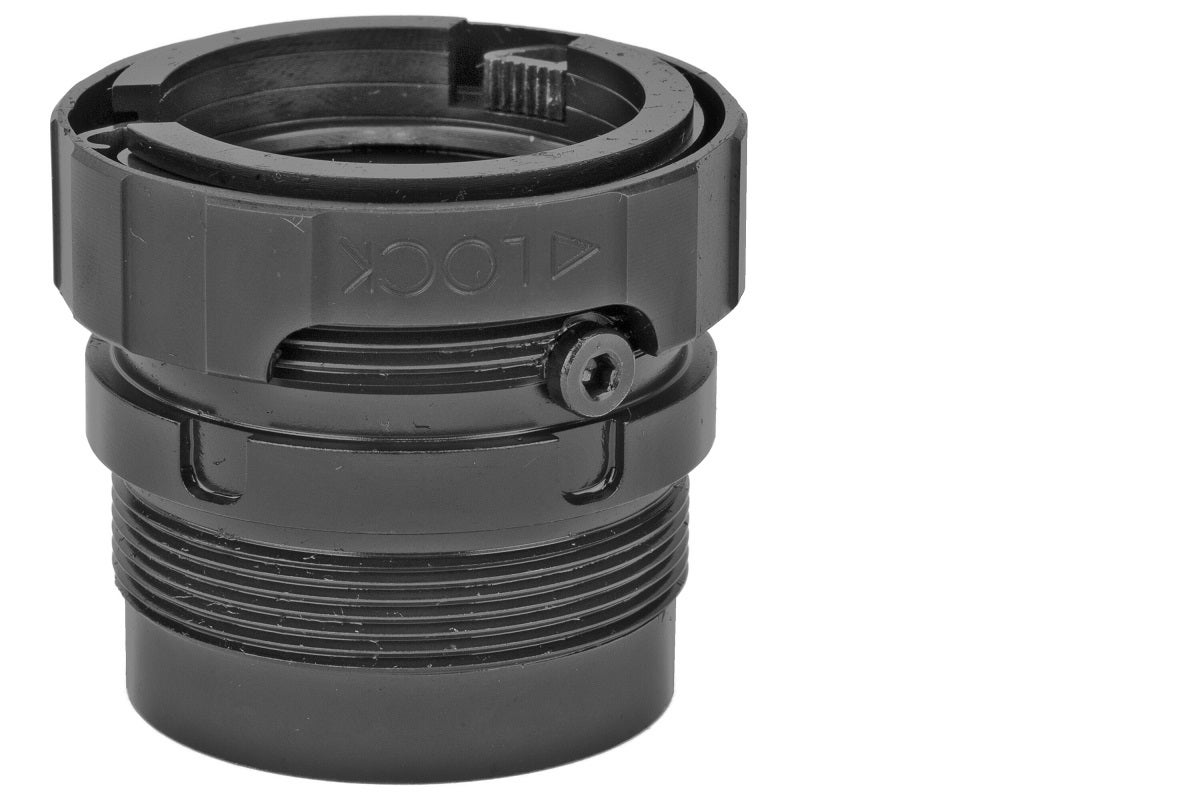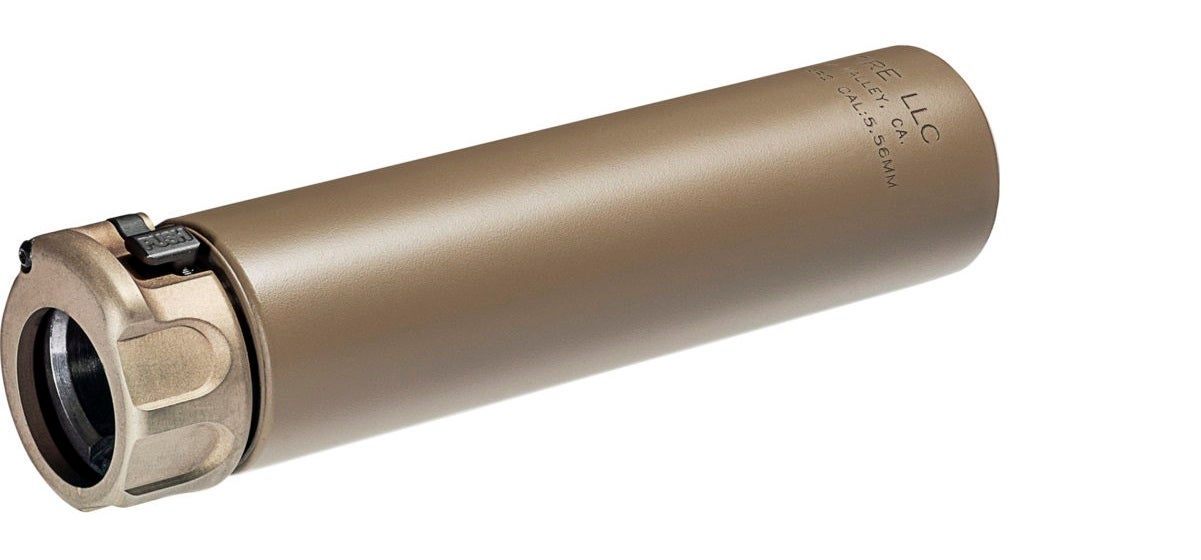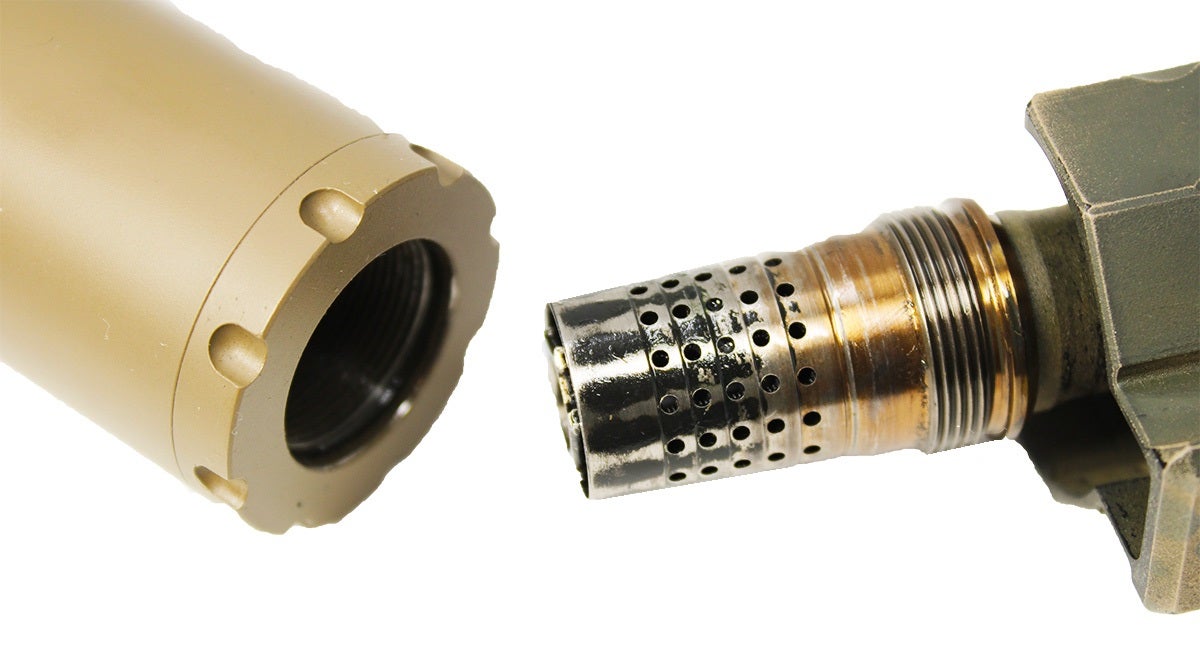Travis Olander 02.02.23
SilencerCo’s ASR… The Griffin Plan A… Don’t forget the Q Plan B (why no plan C?)… And, naturally, the Cherry Bomb…. If all this muzzle muffler jargon sounds like a foreign language, fear not. Today, we’re looking at suppressor mounts. Whether you want to sport a direct thread suppressor mount on your rifle or a quick attach, we will go over the pros and cons so you can decide what might best for what you are using your firearm for.
Suppressor Mounts Come in Two Flavors

Direct Thread – where your can connects directly to your gun barrel’s muzzle. Simple enough. You just need to make sure your barrel’s threads match the thread pattern on your can.

Quick Attach – Also called “QD” (quick disconnect). QD suppressor mounts act as a middleman between your suppressor’s fitting, and your muzzle. They usually take the form of a muzzle device that looks – and sometimes functions – like a brake, or compensator. QD mounts are only compatible with certain suppressor mounting caps. That’s the part of your suppressor that accepts the mount or threads in question.
Direct Thread vs. QD: Pros and Cons
Each mounting system has advantages and drawbacks. Here’s what you should consider when you’re deciding which mounting method to go with.
Direct thread is lighter, cheaper, and simpler.
Direct-thread suppressors make use of simple threads that match the threads on your muzzle — for most handguns and rifles, it’s either 5/8×24 or 1/2×28. There’s no muzzle device required to fit the can onto the barrel. Installing and removing the suppressor means simply twisting on or off.
Direct thread suppressors can get stuck, or come loose.
This is the drawback of going with direct threads. When a suppressor heats up, the metal expand and the suppressor’s likely to come loose. If you “gorilla-arm” it into place with high torque, the heat and cooling of the suppressor could cause it to become stuck. Trying to get leverage on a thin metal tube isn’t easy, and you could damage your suppressor or muzzle.
Going with direct thread fittings also means your suppressor’s only going to work on firearms with the same thread pattern on the muzzle. That means if your can’s threaded for 5/8×24 muzzles, you won’t be able to fit it onto thinner barrels with 1/2×28 threads — even if the bore of your suppressor can accommodate whatever smaller round is chambered in the rifle or pistol in question.
QD suppressors are more convenient, and don’t get stuck.
Quick-attach suppressor systems provide easy on-and-off fittings, often ditching threads entirely. Some use simple spring tension and others use locking rings to provide a secure fit that won’t get loose as your barrel heats up and cools off. Quick-attach fittings also provide a standardized mount. This ensures one suppressor can work on different firearms with various thread patterns.
QD setups are heavier and more expensive.
Adding a special fitting to your muzzle means adding weight. It also means spending more money on what is already an expensive investment. Some QD mounts can wobble just enough to cause a loss in accuracy, too, but this depends on the attachment method.
Types of QD Suppressor Mounts
quick-attach suppressor attachments fall into three categories: Locking passive, non-locking passive, and locking active. Locking QD mounts require some sort of manual input by the user – like twisting or pulling on a metal ring that slips over a joint. Non-locking QD mounts rely on simple friction and taper mounts to remain seated.
Locking Passive Suppressor Mount

A passive locking mount provides one-handed operation. That means the user has to interact with just one moving part on the suppressor to engage the QD lock. The lock is typically a slip ring under spring tension that requires just a quarter turn or temporary pressure on the spring to engage the lock. This passive locking mechanism is how SilencerCo’s ASR mounts function.
Locking Active Suppressor Mount

Locking active mounts use two types of locking mechanisms, and may require two-handed operation. These QD setups use a primary lock that prevents the second lock from engaging or disengaging until it, too, is unlocked. In the case of the Surefire SOCOM 556 suppressor, the primary lock is a push lever, and the secondary lock is a tapered friction fit. Secondary locks can instead be coarse threads, and other primary locks might include a spring-loaded slip ring. Whether active or passive, most locking QD mounts are reserved for heavy-duty suppressors and military customers.
Non-Locking Passive Suppressor Mount

Most QD suppressors use non-locking passive mounts.These QD mounts use simple threads to align and lock the suppressor to the mount with a tapered friction fitting. These mounts are simple, highly repeatable, and provide excellent lock-up that doesn’t come loose from hot and cold cycles. Non-locking passive mounting is what this writer prefers. I run a Q Cherry Bomb on all my muzzles (my 300 BLK SBR is pictured above). The Cherry Bomb fits both 1/2×28 and 5/8×24 muzzles, allowing me to run my .30-caliber suppressor on all my rifles. It also doubles as a great flash hider when i’m not running my can, and it looks good to boot. Lastly, the perforated design helps disperse and slow down gas in the blast chamber, prolonging the life of my can’s blast baffle and aiding in sound suppression.
Which QD Mount is Best, Overall?
The answer to this question changes almost ever year. But it’s this writer’s opinion that a threaded taper fitting like the Q Cherry Bomb provides the best of both worlds. I’ve never had my suppressor come loose or get stuck, and I haven’t lost any accuracy using this mount on my long-range bench rifle. The mount you wind up using largely depends on the suppressor you buy. Some popular models only use certain QD attachments. So, you may just have to compromise and stick with what’s available for the can of your choice. What truly matters is your can’s ability to handle heat and provide good sound suppression. Speaking of heat, you should probably invest in a good suppressor cover to prevent burns.
